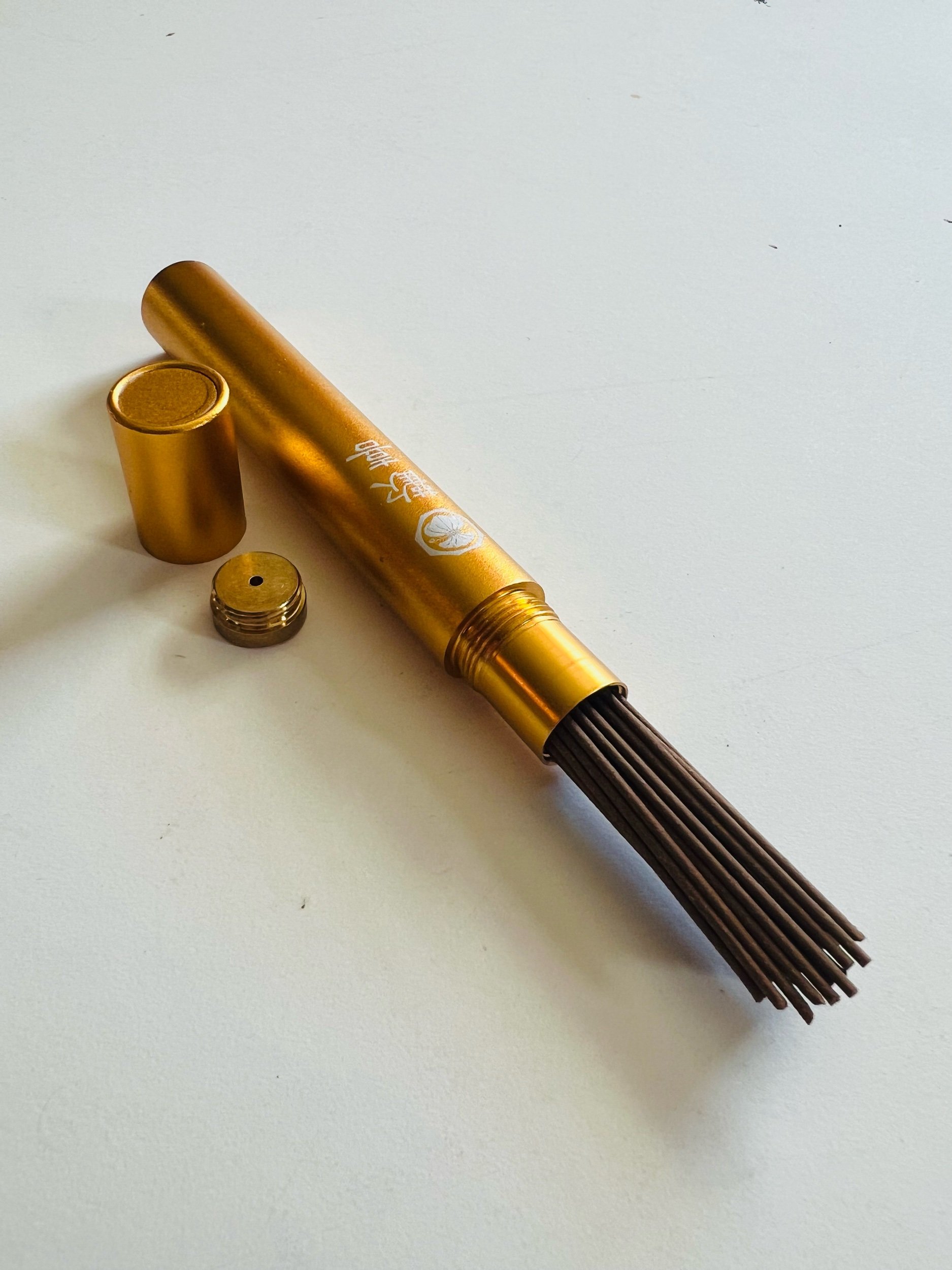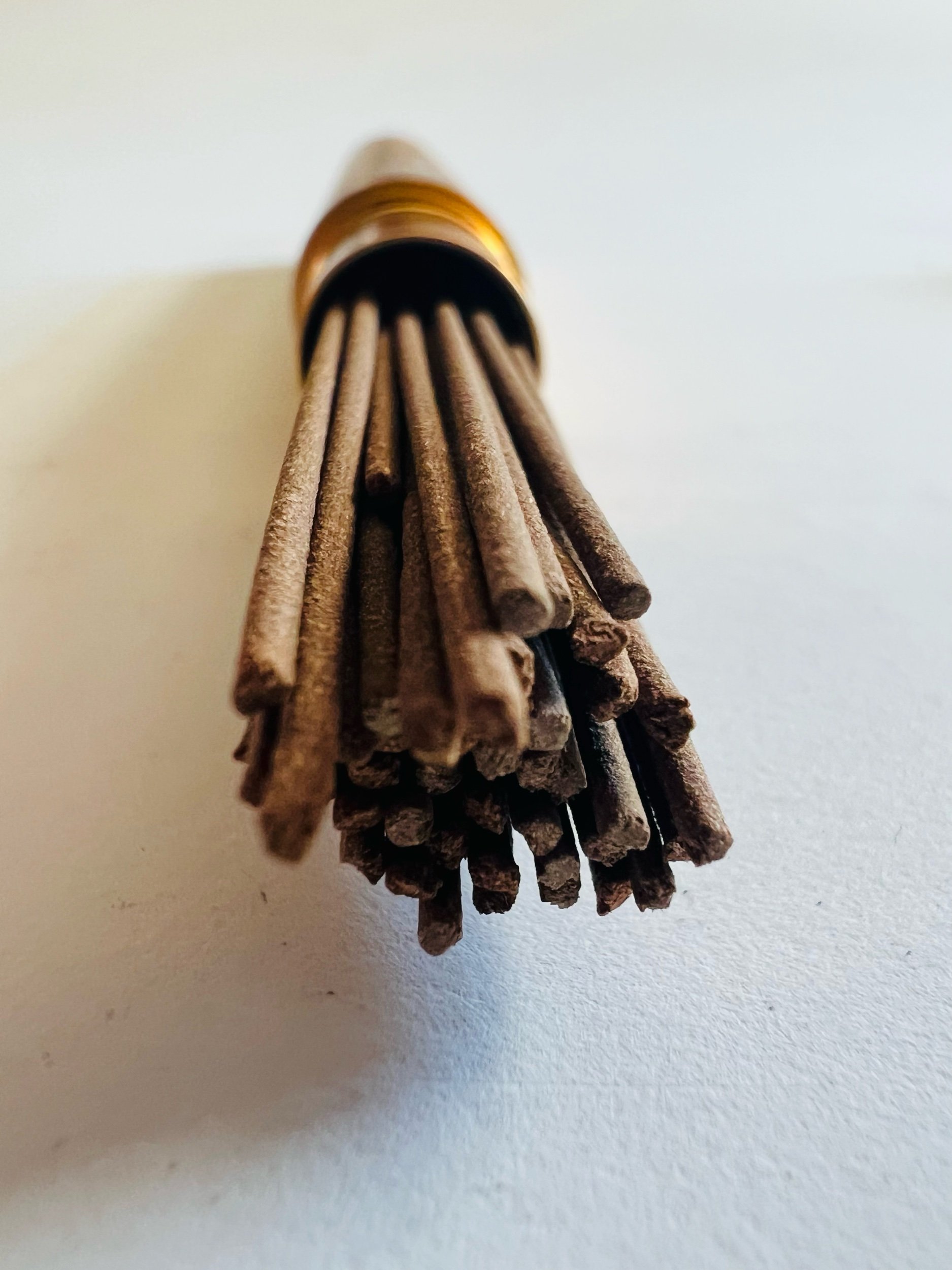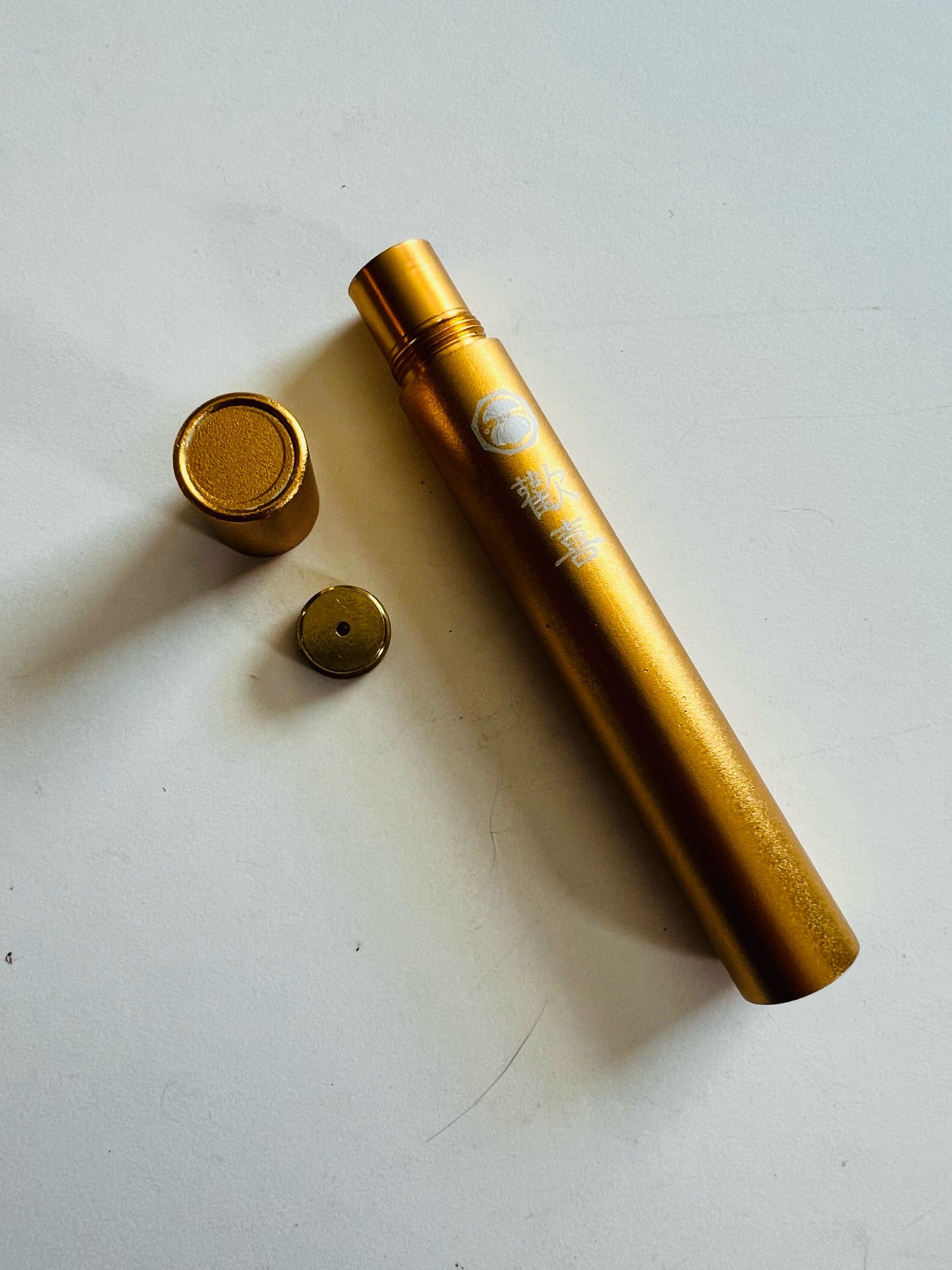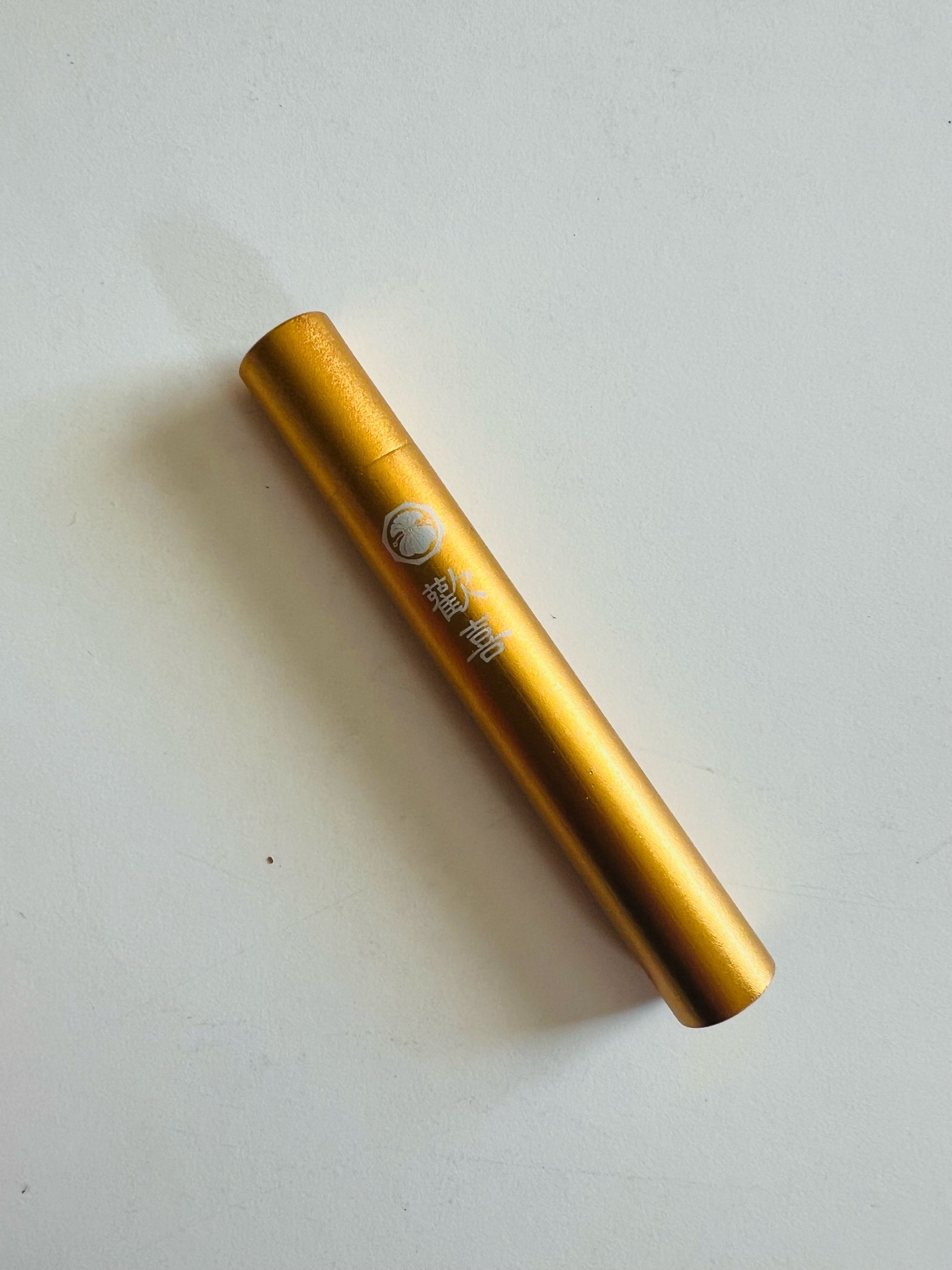 Image 1 of 5
Image 1 of 5

 Image 2 of 5
Image 2 of 5

 Image 3 of 5
Image 3 of 5

 Image 4 of 5
Image 4 of 5

 Image 5 of 5
Image 5 of 5






Agarwood/Aloeswood-Kynam/Kinam ( Vietnam )
.:.Vietnamese Agarwood/Aloeswood/Oud ( Aquilaria Sinensis) .
.:. Vietnam is the only region where the Kynam/Kinam/Kyara resin scent profile occurs. It is the sharpest , most brilliant of all Agarwood, sometimes described as the highest spectrum. It can be categorized into a few different color ranges , Green ( which this incense is) , purple , white , black. It is the heaviest , most resin saturated wood out of any Agarwood, sometimes referred to as “shining grade”, as it is so heavy and resin dense it will sink when placed in water. In order to understand the name of the colors , one must become highly familiar with all the variations to truly tell the difference , as you are literally smelling the scent and the brain automatically categorizes it with the color spectrum.
.:. This specific incense has a sharp and lustrous kinamic top note as it smoothly transitions into the jungley , musty , earthen base notes , balancing the high and low. Truly a masterful creation to be hold. This incense and material is from a Vietnamese plantation , exact ratios of the resin dense heart wood with some of the lighter wood is high density extruded to for this Japanese incense stick, as fully resonated wood can not burn alone. Like the other incense in this series offered , this a meticulously crafted by a multi decade student of these trees , who understands how each material combusts and combines to create an all natural , synthetic/binder/filler free incense.
.:. 5 gram tube , featuring 46 sticks , with a 20+ minute burn time.
Inside the cap , is a secondary metal seal that acts a small travel incense holder as well.
Graphic is of a treasure bag , reminding us of what treasures await us in life. The kanji charectors represent “joyous”, a noble reminder of how meditating with incense can transform us to be able to take in the smaller , subtle , silent joys of life.
.:. For those who have heard the name , but not fully aware of what exactly Agarwood is or how it is formed, here is a brief explanation. In wild habits and how it was first found , the tree undergoes stress, usually attacked by bugs , when this occurs the immune response is to generate resin , this resin content is where the pungent scent is stored, and usually grows in clusters , closest to the pockets , growing just under the shell of the tree and all the way down to the center or heart wood to protect the entirety of the tree. This takes a variety of time , similar to sandalwood or palo santo resin, the liner the resin grows and ages while the tree is alive and dead , the more advance the scent becomes and more complex of a profile. This is the rarest and most expensive and exotic tree resin in the world. Hence the incense and the oil itself , reflecting that by how expensive the material is to gather and grow as well time and material spent processing it . The oil is an entirely different story compared to the incense. As time has gone on , and some species have become endangered, some even extinct, the Ingenuity of the human mind has figured out how to work with it. In so , there are still patches of wild agarwood , yet some have been cultivated and delicately taken care of. Again to sandalwood, the tree takes a minimum of 8-10 years to reach maturity , from that point holes are usually drilled , or other methods, into the trees, causing the bacteria to infect it, thus the immune response occurs to form the resin. Some people slowly take these parts out of the tree and let it continue growing, some people take down the entire tree. Those are just a few insights , there will be a longer blog post to follow, but keeping in mind , this is a life long study and dedication to this entirely complex consciousness of the plant world.
.:{ The Ten Merits of Incense }:.
Endears one to Divine grace,
Purifies the body.
Dispels Negativity, Aids good sleep,
Accompanies the lonesome,
Relaxes the mind.
Endless source of pleasure,
Always satisfying.
Stores well, Excellent for Daily Use
.:.Vietnamese Agarwood/Aloeswood/Oud ( Aquilaria Sinensis) .
.:. Vietnam is the only region where the Kynam/Kinam/Kyara resin scent profile occurs. It is the sharpest , most brilliant of all Agarwood, sometimes described as the highest spectrum. It can be categorized into a few different color ranges , Green ( which this incense is) , purple , white , black. It is the heaviest , most resin saturated wood out of any Agarwood, sometimes referred to as “shining grade”, as it is so heavy and resin dense it will sink when placed in water. In order to understand the name of the colors , one must become highly familiar with all the variations to truly tell the difference , as you are literally smelling the scent and the brain automatically categorizes it with the color spectrum.
.:. This specific incense has a sharp and lustrous kinamic top note as it smoothly transitions into the jungley , musty , earthen base notes , balancing the high and low. Truly a masterful creation to be hold. This incense and material is from a Vietnamese plantation , exact ratios of the resin dense heart wood with some of the lighter wood is high density extruded to for this Japanese incense stick, as fully resonated wood can not burn alone. Like the other incense in this series offered , this a meticulously crafted by a multi decade student of these trees , who understands how each material combusts and combines to create an all natural , synthetic/binder/filler free incense.
.:. 5 gram tube , featuring 46 sticks , with a 20+ minute burn time.
Inside the cap , is a secondary metal seal that acts a small travel incense holder as well.
Graphic is of a treasure bag , reminding us of what treasures await us in life. The kanji charectors represent “joyous”, a noble reminder of how meditating with incense can transform us to be able to take in the smaller , subtle , silent joys of life.
.:. For those who have heard the name , but not fully aware of what exactly Agarwood is or how it is formed, here is a brief explanation. In wild habits and how it was first found , the tree undergoes stress, usually attacked by bugs , when this occurs the immune response is to generate resin , this resin content is where the pungent scent is stored, and usually grows in clusters , closest to the pockets , growing just under the shell of the tree and all the way down to the center or heart wood to protect the entirety of the tree. This takes a variety of time , similar to sandalwood or palo santo resin, the liner the resin grows and ages while the tree is alive and dead , the more advance the scent becomes and more complex of a profile. This is the rarest and most expensive and exotic tree resin in the world. Hence the incense and the oil itself , reflecting that by how expensive the material is to gather and grow as well time and material spent processing it . The oil is an entirely different story compared to the incense. As time has gone on , and some species have become endangered, some even extinct, the Ingenuity of the human mind has figured out how to work with it. In so , there are still patches of wild agarwood , yet some have been cultivated and delicately taken care of. Again to sandalwood, the tree takes a minimum of 8-10 years to reach maturity , from that point holes are usually drilled , or other methods, into the trees, causing the bacteria to infect it, thus the immune response occurs to form the resin. Some people slowly take these parts out of the tree and let it continue growing, some people take down the entire tree. Those are just a few insights , there will be a longer blog post to follow, but keeping in mind , this is a life long study and dedication to this entirely complex consciousness of the plant world.
.:{ The Ten Merits of Incense }:.
Endears one to Divine grace,
Purifies the body.
Dispels Negativity, Aids good sleep,
Accompanies the lonesome,
Relaxes the mind.
Endless source of pleasure,
Always satisfying.
Stores well, Excellent for Daily Use
.:.Vietnamese Agarwood/Aloeswood/Oud ( Aquilaria Sinensis) .
.:. Vietnam is the only region where the Kynam/Kinam/Kyara resin scent profile occurs. It is the sharpest , most brilliant of all Agarwood, sometimes described as the highest spectrum. It can be categorized into a few different color ranges , Green ( which this incense is) , purple , white , black. It is the heaviest , most resin saturated wood out of any Agarwood, sometimes referred to as “shining grade”, as it is so heavy and resin dense it will sink when placed in water. In order to understand the name of the colors , one must become highly familiar with all the variations to truly tell the difference , as you are literally smelling the scent and the brain automatically categorizes it with the color spectrum.
.:. This specific incense has a sharp and lustrous kinamic top note as it smoothly transitions into the jungley , musty , earthen base notes , balancing the high and low. Truly a masterful creation to be hold. This incense and material is from a Vietnamese plantation , exact ratios of the resin dense heart wood with some of the lighter wood is high density extruded to for this Japanese incense stick, as fully resonated wood can not burn alone. Like the other incense in this series offered , this a meticulously crafted by a multi decade student of these trees , who understands how each material combusts and combines to create an all natural , synthetic/binder/filler free incense.
.:. 5 gram tube , featuring 46 sticks , with a 20+ minute burn time.
Inside the cap , is a secondary metal seal that acts a small travel incense holder as well.
Graphic is of a treasure bag , reminding us of what treasures await us in life. The kanji charectors represent “joyous”, a noble reminder of how meditating with incense can transform us to be able to take in the smaller , subtle , silent joys of life.
.:. For those who have heard the name , but not fully aware of what exactly Agarwood is or how it is formed, here is a brief explanation. In wild habits and how it was first found , the tree undergoes stress, usually attacked by bugs , when this occurs the immune response is to generate resin , this resin content is where the pungent scent is stored, and usually grows in clusters , closest to the pockets , growing just under the shell of the tree and all the way down to the center or heart wood to protect the entirety of the tree. This takes a variety of time , similar to sandalwood or palo santo resin, the liner the resin grows and ages while the tree is alive and dead , the more advance the scent becomes and more complex of a profile. This is the rarest and most expensive and exotic tree resin in the world. Hence the incense and the oil itself , reflecting that by how expensive the material is to gather and grow as well time and material spent processing it . The oil is an entirely different story compared to the incense. As time has gone on , and some species have become endangered, some even extinct, the Ingenuity of the human mind has figured out how to work with it. In so , there are still patches of wild agarwood , yet some have been cultivated and delicately taken care of. Again to sandalwood, the tree takes a minimum of 8-10 years to reach maturity , from that point holes are usually drilled , or other methods, into the trees, causing the bacteria to infect it, thus the immune response occurs to form the resin. Some people slowly take these parts out of the tree and let it continue growing, some people take down the entire tree. Those are just a few insights , there will be a longer blog post to follow, but keeping in mind , this is a life long study and dedication to this entirely complex consciousness of the plant world.
.:{ The Ten Merits of Incense }:.
Endears one to Divine grace,
Purifies the body.
Dispels Negativity, Aids good sleep,
Accompanies the lonesome,
Relaxes the mind.
Endless source of pleasure,
Always satisfying.
Stores well, Excellent for Daily Use
